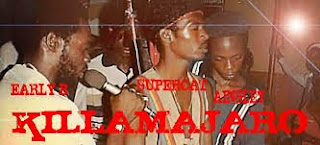Early Career
 Born as Dennis Emmanuel Brown on February 1, 1957 in Kingston, Jamaica. Dubbed by Bob Marley as his successor and called the "Crown Prince" of reggae, Brown was just 12 years old when he created his first hit single, "No Man is an Island." He recorded the song at the famed Studio One Records in 1969, as part of his album of the same name. Brown had begun working toward a music career three years prior to the release of No Man is an Island; at the age of 9, he had begun singing with Byron Lee and the Dragonaires. During concerts, the young Brown stood atop beer boxes so that he could be seen. In 1968, He had caught the attention of Studio One sound system operator Clement "Coxsone" Dodd, and soon began recording at the studio, where Bob Marley had carved out his sound several years before. During an amazing two-day session, Brown recorded two albums: No Man Is an Island and If I Follow My Heart.
Born as Dennis Emmanuel Brown on February 1, 1957 in Kingston, Jamaica. Dubbed by Bob Marley as his successor and called the "Crown Prince" of reggae, Brown was just 12 years old when he created his first hit single, "No Man is an Island." He recorded the song at the famed Studio One Records in 1969, as part of his album of the same name. Brown had begun working toward a music career three years prior to the release of No Man is an Island; at the age of 9, he had begun singing with Byron Lee and the Dragonaires. During concerts, the young Brown stood atop beer boxes so that he could be seen. In 1968, He had caught the attention of Studio One sound system operator Clement "Coxsone" Dodd, and soon began recording at the studio, where Bob Marley had carved out his sound several years before. During an amazing two-day session, Brown recorded two albums: No Man Is an Island and If I Follow My Heart.
Dennis Brown Birthday Bash Jamaica 1997 pt1
Commercial Success
In 1971, Brown released Super Reggae & Soul Hits, which featured a more mature sound and pushed Brown to stardom. His silky, smooth voice endeared him to listeners and record executives, and as his stature grew, so did the demands from record producers who wanted to tap into his success. Over his nearly 30-year career, Brown churned out 80 albums for some 40 different recording labels. His hits include "Some Like It Hot," "Cassandra," "Westbound Train," "My Time," "How Could I Leave" and "Ghetto Girl." His 1972 single, "In My Pocket," landed among the U.K.'s Top 10.
Dennis Brown - Remember Me Always
Brown's career mirrored the changes in reggae music, from lovers' rock to dancehall, to digital. With each change, the easy sounding musician seemed to effortlessly transition. In 1994, he was nominated for a Grammy Award for the album Light My Fire.
Following Bob Marley's death in 1981, many assumed that Brown, who for a time moved to London after signing with A&M Records, would pick up the torch as reggae's leading man. The result, however, was a mediocre stab at pop reggae and the release of three poorly received albums.
Later Years
As Brown transitioned into the 1980s, his drug of choice changed from marijuana to cocaine. He was never able to kick his cocaine habit, which contributed to his early death on July 1, 1999 in Kingston, Jamaica. Just two months before he died, Brown, who fathered 13 children during his lifetime, had been arrested in Brazil for possession of drugs.
In an interview with National Public Radio, Damien Marley, Bob Marley's son, spoke about Dennis Brown's legacy: "He was one of those persons who made it cool to smile in reggae music. When I listen to his music, I can hear that he really loved singing. It almost sounds like he smiles while he's singing."
DENNIS BROWN & FRIENDS








